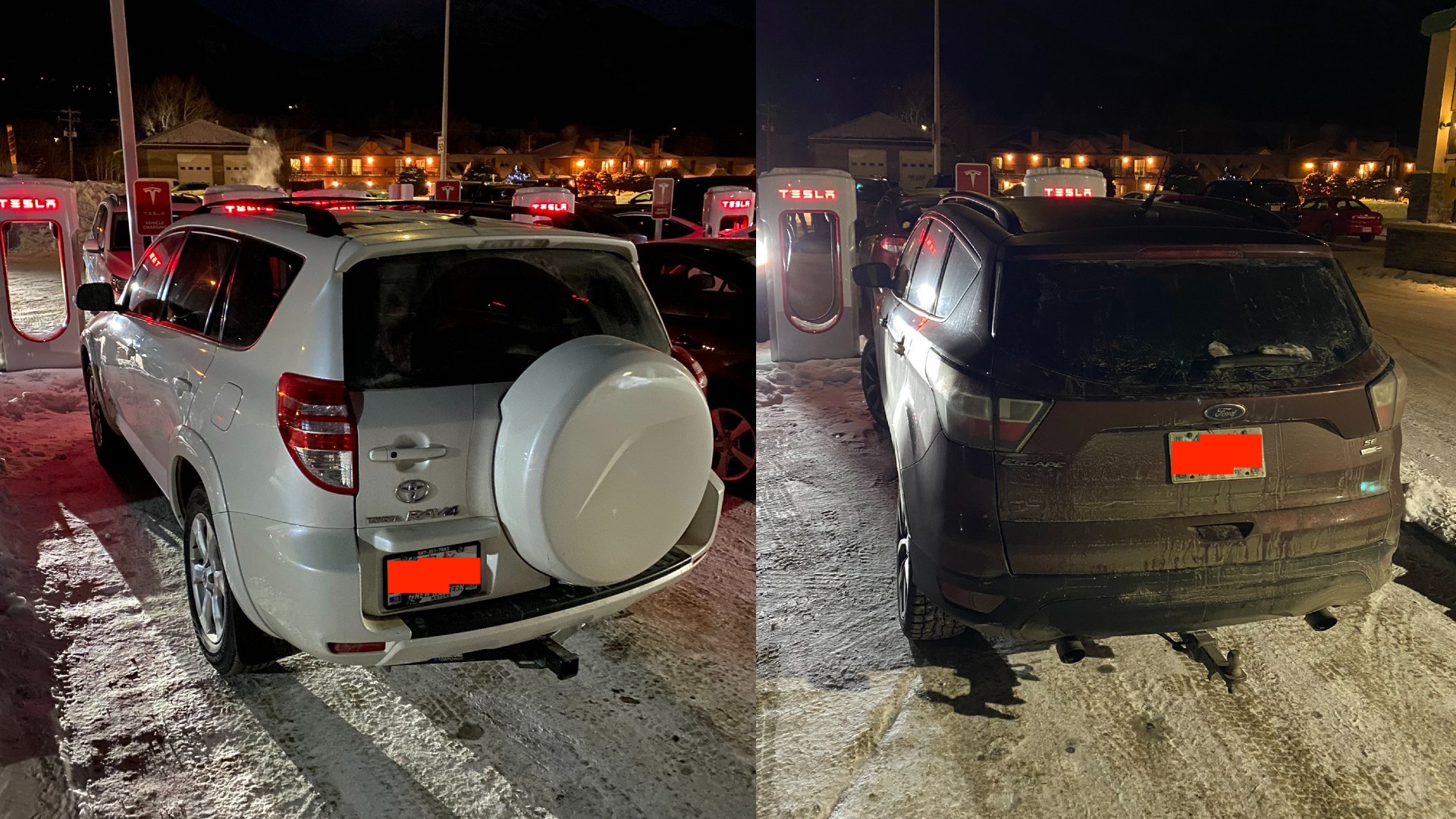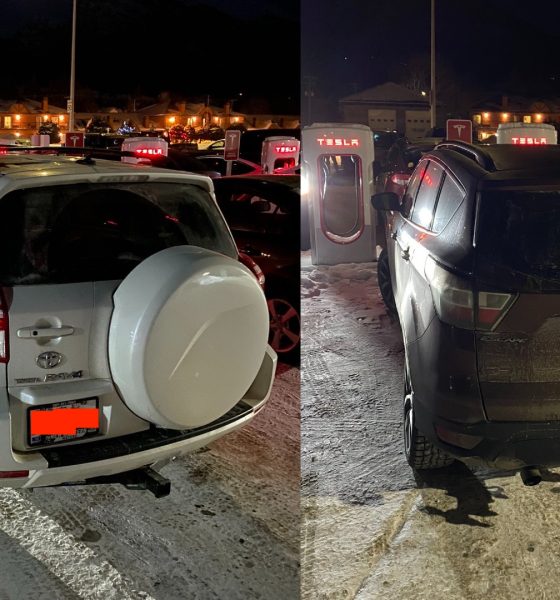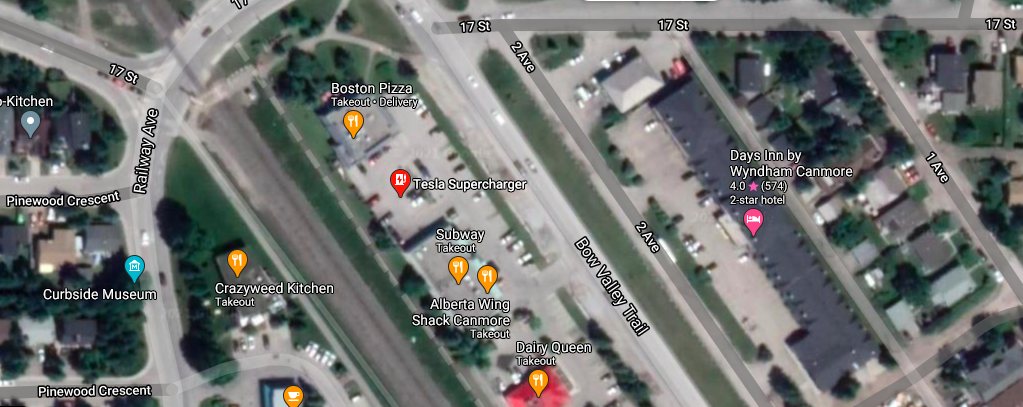

News
Tesla owner faces winter wait as Supercharger station gets blocked en masse
Tesla Model X owner Anshuman Chhabra was in the town of Canmore in Alberta, Canada, when he experienced one of the most inconvenient and annoying things that could happen to an electric car driver. Pulling up into a Tesla Supercharger, the EV owner discovered that most of the charging stations had already been occupied–not by electric cars but by fossil fuel-powered vehicles.
Chhabra shared his experience in a tweet, where he noted that because the entire Supercharger station had been blocked by ICE cars, there was no space left for an electric vehicle to charge. The Model X owner ultimately ended up waiting 30 minutes to access an open slot in the Tesla Supercharger, and that was only because one of the cars blocking a stall moved out.
Parking violations as all charging spots were blocked at the #Tesla supercharger at @TownofCanmore. No spot for Tesla EVs to charge. Had to wait 30 mins before could find a charging spot. Action needed: @RCMPAlberta @DriveTeslaca pic.twitter.com/sSS0JdTK4Y
— Anshuman Chhabra (@anshumanchhabra) February 18, 2021
The practice of blocking electric vehicle charging stations, better known in the EV community as ICE-ing, has been going on for years. While there have been reports of Superchargers being blocked maliciously by anti-EV drivers in the past, a good number of ICE-ing incidents seem to stem from other drivers simply being unaware of the fact that they are not supposed to park at a charging stall.
Considering the Canmore Supercharger location visited by the Model X owner, this may very well have been the case. After all, the site is home to a restaurant and other businesses, which means that patrons who cannot access their designated parking slots may find Tesla’s open charging stalls attractive.

This does not excuse the practice of ICE-ing, of course. However, it does highlight the need for electric vehicle makers like Tesla to adopt some systems or contingencies that could help prevent chargers from being blocked. Tesla China is already adopting such a system, using some innovative locks that only allow access to a charging slot once a Tesla is detected. Regulations and rules from the local government help a lot, too, as they would provide a negative incentive for ICE drivers to block electric car charging stations.
Teslarati has reached out to Canmore about the incident and any local programs that may discourage ICE-ing. As per the town, the property owner or manager would have to send in a vehicle removal form if the blocked Supercharger is built on private property. Blocked Superchargers in Town of Canmore property are easier to deal with, as Tesla owners would only need to report the incident to have officers attend to the situation.
With electric cars being more prevalent, it is high time for ICE-ing practices to be heavily discouraged and anti-ICE-ing regulations to be enforced. States like Colorado have already taken significant steps towards this goal with HB19-1298, a bill that imposes penalties to drivers who occupy EV charging spots without any intention of charging their cars. These are small steps, of course, but they emphasize the idea that EVs should not be blocked from accessing public chargers. ICE-ing is the equivalent of someone blocking a gas pump and leaving, after all, and that’s something that will likely not be tolerated by drivers everywhere.
Don’t hesitate to contact us for news tips. Just send a message to tips@teslarati.com to give us a heads up.

News
Tesla aims to combat common Full Self-Driving problem with new patent
Tesla writes in the patent that its autonomous and semi-autonomous vehicles are heavily reliant on camera systems to navigate and interact with their environment.

Tesla is aiming to combat a common Full Self-Driving problem with a new patent.
One issue with Tesla’s vision-based approach is that sunlight glare can become a troublesome element of everyday travel. Full Self-Driving is certainly an amazing technology, but there are still things Tesla is aiming to figure out with its development.
Unfortunately, it is extremely difficult to get around this issue, and even humans need ways to combat it when they’re driving, as we commonly use sunglasses or sun visors to give us better visibility.
Cameras obviously do not have these ways to fight sunglare, but a new patent Tesla recently had published aims to fight this through a “glare shield.”
Tesla writes in the patent that its autonomous and semi-autonomous vehicles are heavily reliant on camera systems to navigate and interact with their environment.

The ability to see surroundings is crucial for accurate performance, and glare is one element of interference that has yet to be confronted.
Tesla described the patent, which will utilize “a textured surface composed of an array of micro-cones, or cone-shaped formations, which serve to scatter incident light in various directions, thereby reducing glare and improving camera vision.”

The patent was first spotted by Not a Tesla App.
The design of the micro-cones is the first element of the puzzle to fight the excess glare. The patent says they are “optimized in size, angle, and orientation to minimize Total Hemispherical Reflectance (THR) and reflection penalty, enhancing the camera’s ability to accurately interpret visual data.”
Additionally, there is an electromechanical system for dynamic orientation adjustment, which will allow the micro-cones to move based on the angle of external light sources.
This is not the only thing Tesla is mulling to resolve issues with sunlight glare, as it has also worked on two other ways to combat the problem. One thing the company has discussed is a direct photon count.
CEO Elon Musk said during the Q2 Earnings Call:
“We use an approach which is direct photon count. When you see a processed image, so the image that goes from the sort of photon counter — the silicon photon counter — that then goes through a digital signal processor or image signal processor, that’s normally what happens. And then the image that you see looks all washed out, because if you point the camera at the sun, the post-processing of the photon counting washes things out.”
Future Hardware iterations, like Hardware 5 and Hardware 6, could also integrate better solutions for the sunglare issue, such as neutral density filters or heated lenses, aiming to solve glare more effectively.
Elon Musk
Delaware Supreme Court reinstates Elon Musk’s 2018 Tesla CEO pay package
The unanimous decision criticized the prior total rescission as “improper and inequitable,” arguing that it left Musk uncompensated for six years of transformative leadership at Tesla.

The Delaware Supreme Court has overturned a lower court ruling, reinstating Elon Musk’s 2018 compensation package originally valued at $56 billion but now worth approximately $139 billion due to Tesla’s soaring stock price.
The unanimous decision criticized the prior total rescission as “improper and inequitable,” arguing that it left Musk uncompensated for six years of transformative leadership at Tesla. Musk quickly celebrated the outcome on X, stating that he felt “vindicated.” He also shared his gratitude to TSLA shareholders.
Delaware Supreme Court makes a decision
In a 49-page ruling Friday, the Delaware Supreme Court reversed Chancellor Kathaleen McCormick’s 2024 decision that voided the 2018 package over alleged board conflicts and inadequate shareholder disclosures. The high court acknowledged varying views on liability but agreed rescission was excessive, stating it “leaves Musk uncompensated for his time and efforts over a period of six years.”
The 2018 plan granted Musk options on about 304 million shares upon hitting aggressive milestones, all of which were achieved ahead of time. Shareholders overwhelmingly approved it initially in 2018 and ratified it once again in 2024 after the Delaware lower court struck it down. The case against Musk’s 2018 pay package was filed by plaintiff Richard Tornetta, who held just nine shares when the compensation plan was approved.
A hard-fought victory
As noted in a Reuters report, Tesla’s win avoids a potential $26 billion earnings hit from replacing the award at current prices. Tesla, now Texas-incorporated, had hedged with interim plans, including a November 2025 shareholder-approved package potentially worth $878 billion tied to Robotaxi and Optimus goals and other extremely aggressive operational milestones.
The saga surrounding Elon Musk’s 2018 pay package ultimately damaged Delaware’s corporate appeal, prompting a number of high-profile firms, such as Dropbox, Roblox, Trade Desk, and Coinbase, to follow Tesla’s exodus out of the state. What added more fuel to the issue was the fact that Tornetta’s legal team, following the lower court’s 2024 decision, demanded a fee request of more than $5.1 billion worth of TSLA stock, which was equal to an hourly rate of over $200,000.
Delaware Supreme Court Elon Musk 2018 Pay Package by Simon Alvarez
News
Tesla Cybercab tests are going on overdrive with production-ready units
Tesla is ramping its real-world tests of the Cybercab, with multiple sightings of the vehicle being reported across social media this week.

Tesla is ramping its real-world tests of the Cybercab, with multiple sightings of the autonomous two-seater being reported across social media this week. Based on videos of the vehicle that have been shared online, it appears that Cybercab tests are underway across multiple states.
Recent Cybercab sightings
Reports of Cybercab tests have ramped this week, with a vehicle that looked like a production-ready prototype being spotted at Apple’s Visitor Center in California. The vehicle in this sighting was interesting as it was equipped with a steering wheel. The vehicle also featured some changes to the design of its brake lights.
The Cybercab was also filmed testing at the Fremont factory’s test track, which also seemed to involve a vehicle that looked production-ready. This also seemed to be the case for a Cybercab that was spotted in Austin, Texas, which happened to be undergoing real-world tests. Overall, these sightings suggest that Cybercab testing is fully underway, and the vehicle is really moving towards production.
Production design all but finalized?
Recently, a near-production-ready Cybercab was showcased at Tesla’s Santana Row showroom in San Jose. The vehicle was equipped with frameless windows, dual windshield wipers, powered butterfly door struts, an extended front splitter, an updated lightbar, new wheel covers, and a license plate bracket. Interior updates include redesigned dash/door panels, refined seats with center cupholders, updated carpet, and what appeared to be improved legroom.
There seems to be a pretty good chance that the Cybercab’s design has been all but finalized, at least considering Elon Musk’s comments at the 2025 Annual Shareholder Meeting. During the event, Musk confirmed that the vehicle will enter production around April 2026, and its production targets will be quite ambitious.








